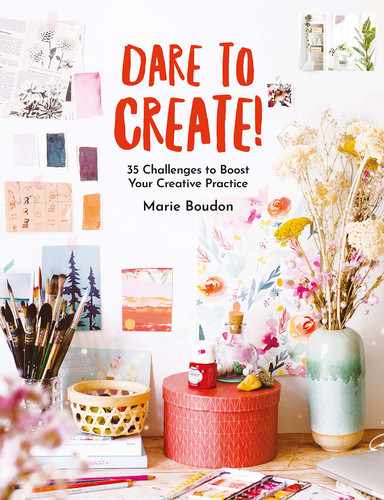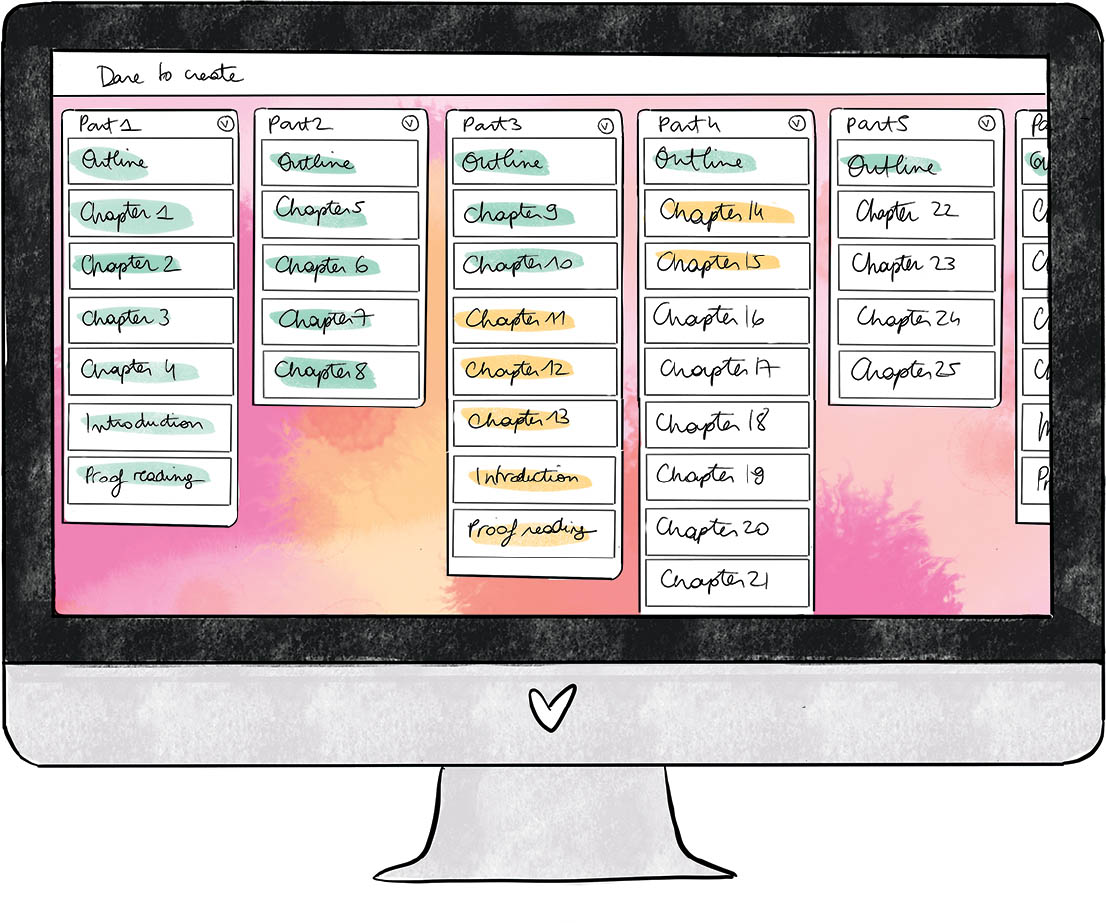 CHALLENGE 8
CHALLENGE 8 
Defining a creative goal
YOU’RE ALMOST READY! BEFORE JUMPING IN, DEFINE AN EFFECTIVE AND CONCRETE CREATIVE GOAL, USING THE MULTIPLE SUGGESTIONS AND METHODS IN THIS CHALLENGE. THIS WILL PROVE ESSENTIAL FOR GUIDING YOU AND HELPING YOU TO KEEP UP YOUR MOTIVATION OVER THE LONG TERM.
What is the purpose of a creative goal?
Moving forward without a goal, as an artist on your own, just letting yourself be carried wherever inspiration takes you, is not easy, especially if you are a self-taught beginner. I believe that defining a creative goal has the following advantages:
![]() Making your creative project concrete: If it’s written down, it’s real. Taking the time to think about your creative dreams and planning your strategy is as important as getting started. Setting this intention makes your project real and helps you to move forward.
Making your creative project concrete: If it’s written down, it’s real. Taking the time to think about your creative dreams and planning your strategy is as important as getting started. Setting this intention makes your project real and helps you to move forward.
![]() Providing a reassuring framework: Having a goal simplifies your decision-making process. It’s easier to start a creative session if you know what direction you’re going. And it will make it easier for you to manage your distractions and doubts.
Providing a reassuring framework: Having a goal simplifies your decision-making process. It’s easier to start a creative session if you know what direction you’re going. And it will make it easier for you to manage your distractions and doubts.
![]() Fighting boredom: This kind of approach will also help you to stay motivated and to feel more enthusiastic. Because you are responding to a challenge, you will avoid inertia and boredom.
Fighting boredom: This kind of approach will also help you to stay motivated and to feel more enthusiastic. Because you are responding to a challenge, you will avoid inertia and boredom.
![]() Getting to a higher level: Having a goal will push you to move to a higher level, because it will be easy to evaluate your progress. When you see everything that you are able to accomplish, you will develop your confidence in your art.
Getting to a higher level: Having a goal will push you to move to a higher level, because it will be easy to evaluate your progress. When you see everything that you are able to accomplish, you will develop your confidence in your art.
Different kinds of goals
In his book The Passionate Photographer, the American documentary photographer Steve Simon lists different kinds of goals:
![]() project goals: these allow you to complete a personal or professional project.
project goals: these allow you to complete a personal or professional project.
![]() technical goals: these involve mastering a new skill, gaining expertise in your preferred practice, or taking a class.
technical goals: these involve mastering a new skill, gaining expertise in your preferred practice, or taking a class.
![]() material goals: these involve obtaining new materials and mastering their use.
material goals: these involve obtaining new materials and mastering their use.
![]() artistic goals: these will push you to research new sources of inspiration (challenge 13), to seek out critiques and feedback, to share and collaborate, to nurture your sensitivity (part 6).
artistic goals: these will push you to research new sources of inspiration (challenge 13), to seek out critiques and feedback, to share and collaborate, to nurture your sensitivity (part 6).
![]() professional goals: these will lead you to build or consolidate your portfolio, sell your products, and exhibit your work.
professional goals: these will lead you to build or consolidate your portfolio, sell your products, and exhibit your work.
Which kind of goal best corresponds to your current creative desires? Your choice doesn’t have to be final—remember that you can change your goal over time as you evolve.
Defining an effective goal using the SMART method
This method will help you make a simple goal into an effective and motivating objective. The SMART method was first outlined by the American consultant George Doran in the journal Management Review in 1981. It became very popular in the professional world, but it can also be applied to your personal and creative life. The idea is to define a goal that has the following characteristics:
Sas in specific: the goal should be clear and precise.
Mas in measurable: it is easy to measure whether or not the goal has been met.
Aas in attributable: who is in charge of making it happen? Since we are talking here about personal goals, I replace “attributable” with “ambitious.” When you look at your goal, you should be thinking: “This is ambitious for me.”
Ras in realistic: the goal should still be realistic. You should be confident in your ability to accomplish the goal.
Tas in timely: the goal needs to be achieved within a certain time limit. The idea is not to define a plan of action that is spread out over five years but to think in the shorter term: three to six months, maximum. It’s better to give yourself small goals to meet within shorter time periods than an enormous and unmanageable five-year goal.
An ambitious but realistic goal means that it is exciting and motivating but not impossible. At first, don’t choose as a goal that you’re going to be exhibiting three canvases in a major museum a month later. Setting goals that are too ambitious will just frighten you and can lead to procrastination. I urge you to aim high but to stay realistic, given your level and the time frame you have in mind.
As an example, the SMART goals that I gave myself were: to paint one floral watercolor per day for fifteen days and share them on Instagram, to start a video course on watercolor basics within three months, and so on.
Setting one goal at a time thanks to creative sprints
If you’re like me, you may have ten different creative goals in mind. I suggest that you only work on one of them at a time. This helped me tremendously to produce higher-quality work and to relieve some of the stress caused by switching between projects too often. Start with the simplest goal. Achieving it quickly will provide you with some essential motivation at the beginning of your creative adventure.
In order to work on one goal at a time, I use a technique that is common in the IT world: agile methodology sprints.
A creative sprint is a two-week period dedicated to one single goal. This is a long enough time period to become immersed in the subject, but short enough that you won’t get bored. If the goal is too large for this time frame, I break it down into several different creative sprints. I used this method, for example, to write this book.
But even if your goal meets the criteria of the SMART method, you might still be paralyzed by self-doubts: “It’s not even worth starting. It’s too complicated. I’ll never manage it.” Breaking down your goal will help you to visualize the small steps that are necessary for achieving smaller, intermediate victories (which you should still celebrate!). This will also make it easier for you to look forward to your creative sessions. And indeed, thinking ahead about what you want to do is another way to conquer the blank page.
I use the Trello application to organize my creative sprints. This is my Trello chart for the preparation for this book. This helps me to visualize the different tasks, thanks to the card-based format. I can easily allot my cards across fifteen-day periods and follow my progress that way.
Balancing goals with the unexpected
Be flexible with your goals. The ideal is to complete your project so that you can meet your goal, but if something unexpected arises and you feel the need, allow yourself the possibility of letting it go or changing it. Your goal is there to guide you and motivate you, not to keep you from moving forward and evolving.
Also, do not completely block your inspiration with the excuse that it doesn’t match your goal. Again, your goal is there to help you stay concentrated and not get distracted, but sometimes it is important to follow an intuition and to take an unexpected detour. The path to your goal will probably not be straight.
Take advantage of everything about the creative process. Enjoy it 100 percent. Don’t just focus on the expected result of the goal you have set. With a little more experience and perspective, you will find that you might have less of a need to regularly define very precise goals.
![]() Your Turn
Your Turn ![]()
- 1. Define your first goal, using the SMART method.
- 2. If you have other ideas for goals, write them in your creative journal and save them for a little later.
- 3. If reaching your goal is going to take more than a month, I suggest that you break it down into several two-week sprints.
- 4. Don’t be afraid to post the goal you have set somewhere where you can reread it frequently so that you can always keep it in mind.


